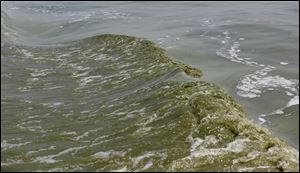
Lawmakers urged to act, stunt Lake Erie algae growth
Critics argue measures to address issue lagging
8/5/2014
Algae is visible in the wake created by a boat in Lake Erie, near the Toledo water intake crib.
COLUMBUS — The alarm sounded with Grand Lake St. Marys four years ago. The alarm just heard in Toledo was much louder, but critics argue that the agricultural industry, lawmakers, and bureaucrats are still moving too slowly to address the causes of toxic algae growth in Lake Erie.
Lawmakers are out of town for the summer and may not return until after the Nov. 4 election.
“This emergency situation demands emergency action,” said Jack Shaner of the Ohio Environmental Council. “We see the House of Representatives have September dates scheduled ‘if needed.’ If this isn’t the definition of ‘if needed,’ I don’t know what is.”
Last spring, lawmakers unanimously passed Senate Bill 150, seen as a key step in addressing the nutrient-runoff problem considered to be a major player in the recurrent toxic algal blooms on Lake Erie.
TOLEDO WATER CRISIS: Get the full story with articles, photos, and video
The law would require state certification for the application of chemical fertilizers on farms of 50 or more noncontigiuous acres. The state hopes to submit proposed rules for review later this month.
Even when fully implemented, the rules will not be mandatory until Sept. 30, 2017, and won’t touch on the application of manure as a fertilizer on frozen ground.
“Toxic algae does not distinguish between the source of a nutrient,” state Sen. Edna Brown (D., Toledo) said. “Phosphorus is phosphorus, regardless of whether it originates from commercial fertilizer or animal manure.”
She plans to introduce a bill specifically adding animal manure to the list of fertilizers regulated by the state. Rep. Mike Sheehy (D., Oregon) will do the same in the House.
“Carroll Township in Ottawa County had an incident lasting three or four days in September, 2013, when they actually had to shut down their system due to microcystic toxic algae,” said state Sen. Randy Gardner (R., Bowling Green). “That affected 2,000 people. The question is, if that had been Toledo in 2013, would we be in the same place today. The answer is no. When it affects 500,000 people, that elevates the issue.”
While underlying causes are important, Mr. Gardner said the immediate focus has to be public health.
“It doesn’t just mean the city of Toledo,” he said. “There are a fair number of communities [with water intake] — Oregon, Carroll Township, Marblehead, and then into Erie County. Ohio [Environmental Protection Agency] should help to provide for more frequent testing and analysis. … It isn’t a question of money. Clean water is a fundamental human necessity.”
State Sen. Cliff Hite (R., Findlay), sponsor of Senate Bill 150 and chairman of the Senate Agriculture Committee, said experts predicted a bad year for algal growth.
“They said, ‘Look out for August,’ and they were right,” he said. “Now we need to see if the first steps are going to have an effect. ... We said this was just a start when we passed [Senate Bill] 150.”
Another measure, House Bill 490, awaits lawmakers’ return this fall, but it also doesn’t address the spreading on frozen ground of manure from large animal operations.
The bill deals with a wide range of agricultural issues, including nutrient management planning by large animal-feeding operations, and places responsibility for regulating it with the Department of Agriculture.
State Rep. Dave Hall (R., Millersburg), chairman of the House Agriculture and Natural Resources Committee and the bill’s sponsor, said he may hold a hearing on the Toledo crisis even before lawmakers return ot Columbus. But he said pinpointing the cause is not going to be easy.
“It’s bigger than just Ohio,” Mr. Hall said. “It becomes international with Canada and the other states. This has to be a partnership. With Grand Lake St. Marys, we were able to start addressing the issue because the encompassing counties were all in Ohio, where we had jurisdiction.
“We have to find out if we have major infrastructure issues along the lake. … We’re looking at old infrastructure and dealing with a toxin that is getting through the system now.”
Recent budgets invested millions to helping farmers implement best practices, better monitoring tributaries feeding the lake, and finding alternatives for the dumping of sediment dredged from lake harbors other than in the open lake.
“When it comes to the lake, we remain vigilant, and as we do our after-action review of the events in Toledo, we’ll be looking for any new ways and ideas to continue to improve policies that impact the lake,” said Rob Nichols, spokesman for Ohio Gov. John Kasich.
Meanwhile, Rep. Chris Redfern (D., Catawba Island), chairman of the Ohio Democratic Party, on Monday called for Mr. Kasich to withdraw his Friday appointment of Rick Hodges, director of the Ohio Turnpike and former state representative from Fulton County, as state health director.
Mr. Redfern argued that Mr. Hodges doesn’t have the required experience in health-related fields to deal with public health emergencies such as the Toledo water crisis.
Contact Jim Provance at: jprovance@theblade.com or 614-221-0496.